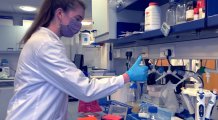articles

CalcifEXE is Exeter's entry to the 2020 International Genetically Engineered Machine (iGEM) competition.
Bacteria and 3D printers could help restore coral reefs
A team of University of Exeter students are using genetically engineered bacteria to produce a material that could help repair degraded coral reefs.
Their project, called CalcifEXE, uses bacteria to make calcium carbonate which can then be shaped using a 3D bioprinter into coral "backbones" for reef restoration.
Production of high-quality Precipitated Calcium Carbonate (PCC) usually requires high temperatures and therefore leads to carbon emissions.
But the team's bacteria-based method produces no emissions – instead taking carbon from the air and locking it into the PCC.
CalcifEXE is Exeter's entry to the 2020 International Genetically Engineered Machine (iGEM) competition.
"Our first step was engineering Bacillus subtilis bacteria to increase its capacity and ability to precipitate calcium carbonate," said CalcifEXE team member Anna Donnan, a third-year Biological Sciences student specialising in cellular and molecular biology.
"To do that, we introduced an enzyme that removes CO2 from the air and converts it into bicarbonate ions.
"This is part of a process called 'biomineralisation', where living organisms produce minerals."
The team aims to use a two-chambered bioprinter containing a bacterial "co-culture" – pairing their genetically engineered B. subtilis with another bacteria to increase calcium carbonate production – and a hydrogel.
The hydrogel contains an "inducer molecule" which activates the bacteria to make solid calcium carbonate.
The CalcifEXE method creates "endless possibilities", the team say.
"PCC is used in many industries," said Eloise Martin, a fourth-year studying MPhys Physics.
"It is used to whiten paper and increase the brightness of colours in eyeshadow, it combats heartburn and indigestion in the form of tablets, and it can be found in your toothpaste as a cleaning agent.
"As a proof of concept, the first use of our PCC will be as coral backbones.
"These are intended to provide an organic 'skeleton' which can be inhabited by coral species – especially in the many places worldwide where coral reefs have died or become degraded."
The team need to test their coral backbones thoroughly before they can be placed in degraded reefs to assist with restoration.
Martin added: "As a physicist, the world of genetically modified bacteria was a foreign one.
"But this competition has made me realise my love for it.
"3D printing limestone using bacteria opens up a multitude of avenues; from medical applications to environmental, it could revolutionise the way we create tailored products."
Matthew Turk, a third-year Biological Sciences student, added: "Our iGEM team this year has had to face the unprecedented challenge of working on our project during the global Covid-19 pandemic.
"Although initially this hindered our progress, we rapidly learnt to adapt our work style so that, despite working remotely, we could explore the more niche avenues of the scientific process.
"Indeed, on reflection, the pandemic opened many previously unexplored avenues for our team and allowed us to focus heavily on issues we are all passionate about, especially in a time where we are all relying on science."
The results of the iGEM competition will be announced this month, with this year's events held online due to the pandemic.
Professor John Love, of Exeter's BioEconomy Centre, said: “I and the other members of the supervisory team, Dr Chloe Singleton and Dr Mark Hewlett, are very proud of the students for taking up the challenge of this innovative and far-reaching project under the shadow of Covid-19”.
Date: 19 November 2020
